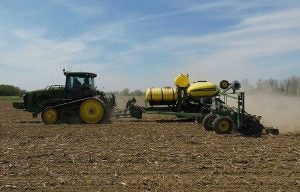It’s 2023 — otherwise known as a farm bill year to those keeping an eye on all things policy related — and things are off to a rocky start as the 118th Congress gets settled in (if you can even call the already increasing tensions between Republicans and Democrats “settled”). Talks about the farm bill not being able to be passed by October of this year have appeared a lot in the news lately. Add in some freshman lawmakers who have never negotiated a farm bill and you have some major foreshadowing to support this theory, it seems.
Needless to say, Congress and the farm bill are in a complicated relationship. The first farm bill listening session, which was supposed to take place on January 7, with House Agriculture Committee Chairman G.T. Thompson (R-Pa.), was postponed due to the House Speaker debacle. It is now rescheduled for January 13.
However, even just two weeks into the year, farm bill talks are already far behind and anticipation of the legislation not being passed before the current legislation expires this fall is real.
But, why is it so hard to pass a farm bill? What all goes into passing such a hefty piece of legislation? And what if it doesn’t get passed in time?
Each time the farm bill must be renewed, the world is in a much different place than it was five years prior — so the farm bill is always evolving. In 1933, when the first farm bill was enacted, it focused on commodity price support and relief for farmers. Now, the largest portion of the bill focuses on the nutrition title (which houses the SNAP program). Between farm bill 2018 and 2023, we have gone through a global pandemic, supply chain disruptions, a war, and many other events that may change the demands of what the farm bill provides going forward.
Now, mix together a new Congress where the House has a slight Republican majority and the Senate has a Democratic majority, and you’ll have a perfect recipe for lots of disagreements in what this omnibus bill should provide to each title. In a perfect world, politics wouldn’t be so … political, and what’s best for everyone could be voted on smoothly. However, this split means that some of the more controversial pieces of the farm bill will be hotly debated and dragged out, to the point of possibly delaying the passing of a new bill this year.

The topics predicted to be debated the most include climate, crop insurance, immigration and nutrition. The farm bill is also known as the “food and farm bill,” because it doesn’t only concern the farming industry, it concerns urban communities and people who don’t farm for a living just as much.
The majority of the farm bill funding surprisingly goes to SNAP (known also by its full name, the Supplemental Nutrition Assistance Program), while less than 10 percent each will be allocated to crop insurance, conservation, and commodities. Disagreements have, historically, been due to the attempt to reduce the size of the nutrition title in the legislation, to make more room for farm policy support. In 2018, the House voted to separate the nutrition program from the farm bill, but ultimately had to keep it attached due to Senate members refusing to vote for a farm bill where nutrition programs are not connected to farm programs.
Ironically, this bill is described as being “bipartisan,” but that doesn’t mean there aren’t some heated debates and major sacrifices made by either side in order to get the final bill passed.
From the ground up
Voting, much less creating, a massive farm bill isn’t that straightforward, but there is a process to getting one built.
There are three major stages to getting a farm bill passed: reauthorization, appropriations, and rulemaking. Under each stage are a lot of working parts.
The first stage, reauthorization, is where most of the excitement happens. It starts with committee hearings, where the House and Senate Agriculture Committee members hear from stakeholders about their priorities for the farm bill. If you ever wondered how you can have an impact in forming the next farm bill, this is where you come in as an advocate and member of industry organizations who vote on farm bill priorities. This step usually begins in the year prior to a new bill being formed.
Marker Bills, which are smaller bills with policy proposals that legislators hope are incorporated into the farm bill, are introduced around the same time as hearings begin. These smaller bills set the tone for the discussions and debates for the upcoming farm bill.

The Congressional Budget Office must then build a budget for the farm bill. This is where things get dicey because any cost increases from their budget must be offset by cuts.
The next step includes the draft bills. The Senate and House Agriculture Committee Chairs both write full drafts of the farm bill and then must present each to the opposite committee. This is where debates, amendment proposals and voting all take place.
The drafts created by each the Senate and House Agriculture Committees are taken to the full House and Senate. More debate and amendments, as well as voting on each version, also take place here.
Once both draft bills are fully approved by the House and Senate, a Joint Conference Committee, made up of senior members of each agriculture committee, works to blend both drafts into one, hopefully bipartisan, bill that is intended to pass without further debate or amendments. The final bill, as it is called, goes back to the House and Senate for a final vote. If it passes, the bill is then presented to the president, who will either sign or veto it. If it is vetoed, Congress must vote. If two-thirds of each house votes to pass the bill, the president’s veto is overridden and the bill becomes law. If the bill doesn’t get a majority vote, then the bill effectively dies with the president’s veto.
The second stage is called “Appropriations.” This is where discretionary and mandatory funding come into play for the policies wrapped into the farm bill. Mandatory funding is “mandated by statute (i.e. the farm bill) and is disbursed automatically each year the farm bill is in effect, while discretionary funding is subject to the annual appropriations process in Congress.”
The nutrition, commodities, crop insurance, and conservation titles are examples of mandatory, while all other titles and programs are mostly discretionary. In order to get funding for these programs, the House and Senate Appropriations Committees must pass an annual Agriculture Appropriations Bill.

Finally, the last stage in the farm bill process is “Rulemaking.” This is where the U.S. Department of Agriculture must administer the programs from the farm bill. If you thought you didn’t have any more say in how the farm bill is implemented, you were wrong. This step allows policy advocates and the general public to weigh in on the rules and regulations that the USDA proposes for how the farm bill is implemented. The comment window is usually open 30 to 90 days.
Once the comment period ends, the USDA will review all public input and decide which to incorporate into the rule. The agency may also decide not to incorporate any, if it so chooses. The final rule is then made, and farm bill programs are administered.
This is all fine and dandy, but what happens if the current bill expires before congress can agree on a new bill?
Farm bill programs with mandatory funding would no longer operate because they wouldn’t have funding available. Those with discretionary funding would possibly change, because there is no authorizing language to dictate how these programs are run. However, these programs could continue to operate due to the way their funding is structured.
The exception to this includes the SNAP and federal crop insurance. These programs are funded through other means: SNAP by means of the appropriations process, and crop insurance by means of the Federal Crop Insurance Act. Neither language, nor funding would change for these two if the farm bill expires.

Some programs, though, would revert back to their old permanent law, which means they would be governed based on law established in the 1930s and 40s. Although these programs have changed over time, the changes only last as long as the current bill does. This causes obvious problems that would be costly to taxpayers, consumers and the government.
Farmbilllaw.org explains one example of this from the 2018 farm bill process:
“One especially dramatic example of the problems of reversion is the Dairy Product Price Support Program. Farm Bills over the past decades have changed the program significantly, but if no new farm bill is passed, the program would revert to its original version. According to a 2014 calculation, reversion to permanent law in this program would require USDA to buy manufactured dairy products at about four times the then-current price, resulting in tremendous increases in government spending on the program as well as consumer dairy prices. In addition, because of modern international trade, with its incredible speed and refrigeration capacity, the United States government would eventually buy the dairy products of potentially all global producers.”
However, If Congress fails to come to an agreement, they can pass a short-term extension of the farm bill, or some other government funding to help fill the gap until they can come to an agreement on new policy. So, while concerns are legitimate about not having a farm bill renewal in 2023, there are hopefully safety nets to prevent our farm policies from traveling back in time.
Markie Hageman Jones majored in agribusiness at Fort Hays State University. She is actively involved in her state Cattlemen’s Association, Young Farmers chapter, and National Cattlemen’s Beef Association. Her AGDAILY.com articles can be found here.



